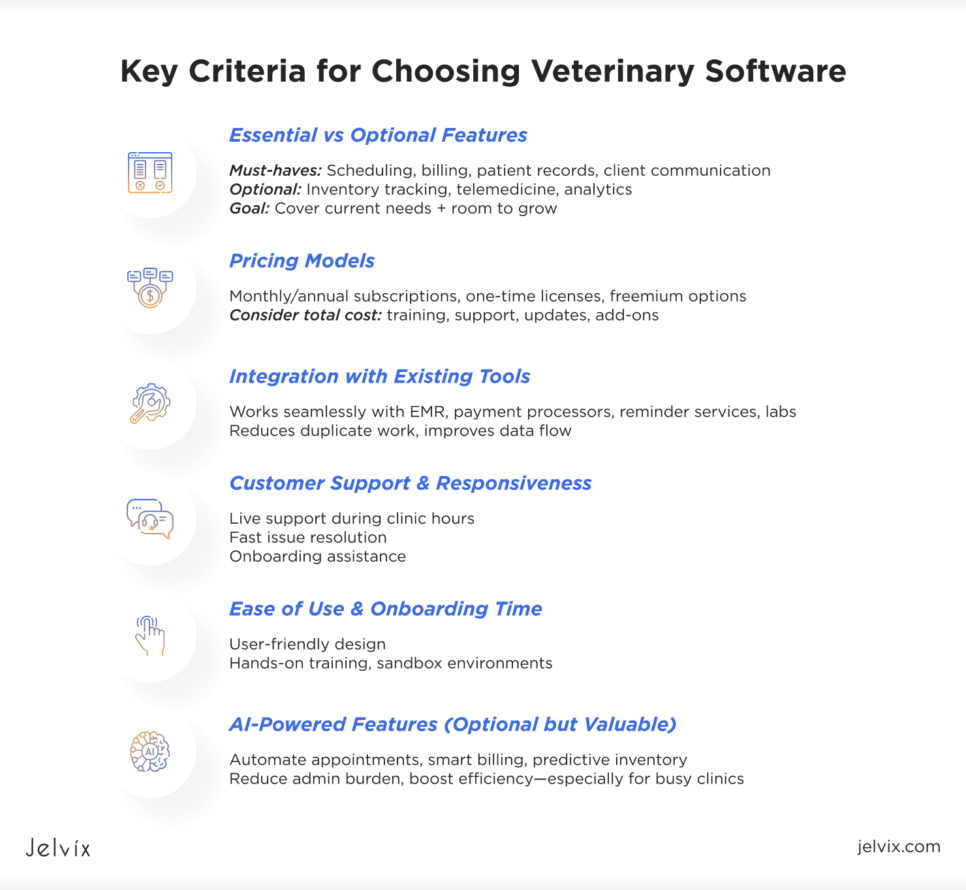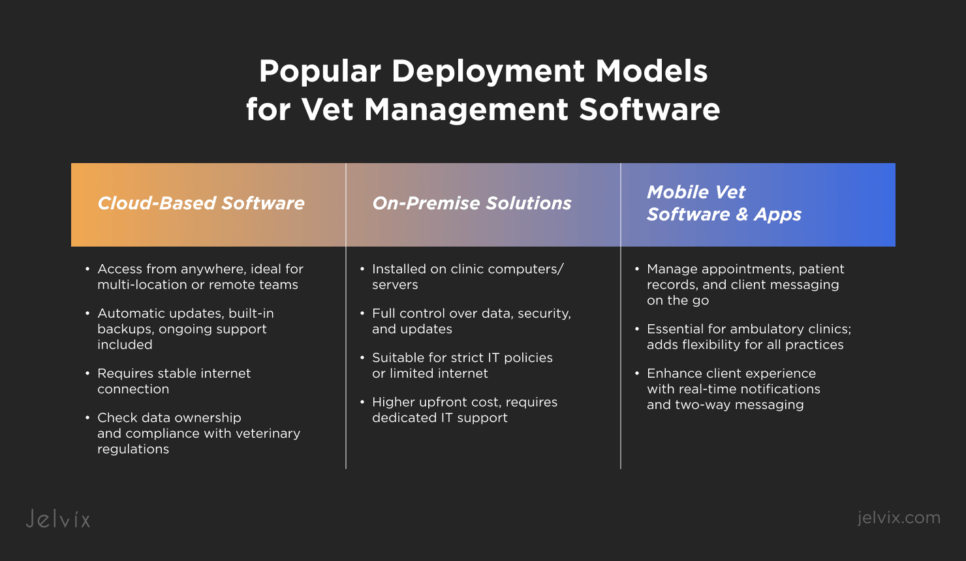Running a modern veterinary clinic demands efficient digital tools to handle complex operations and enhance client experiences. That is why global adoption of veterinary office management software is on the rise, with its market projected to surpass USD 674 million by 2031.
The problem is that choosing the right tool can be challenging. Numerous platforms offer overlapping features but vastly different pricing, usability, and support, which complicates the matter, especially for growing clinics with limited resources.
If you want to find veterinary office management software that can automate manual processes, reduce the number of errors, and fit your budget, read this article. You’ll learn more about the essential features to consider, discover the pros and cons of different options, and get a comparison of leading VPMS solutions in 2025.
What Is Veterinarian Practice Management Software?
Veterinary practice management software, or VPMS, is a digital system that helps veterinary clinics handle the day-to-day operations that keep the practice running. It combines tools for scheduling, billing, patient care, and communication into one streamlined platform.
At its core, VPMS is designed to reduce paperwork, prevent scheduling errors, and ensure that every patient visit, from a routine checkup to an emergency surgery, is documented, billed, and followed up correctly. For veterinary teams, it means spending less time managing spreadsheets or chasing down files and more time focused on animals and their owners.
Most systems include features like appointment scheduling with automated reminders, electronic medical records, invoicing and payment tracking, inventory management, and built-in communication tools that allow clinics to text, email, or call clients directly from the platform.
However, if you opt for custom medical software development services, you can expect to have telemedicine capabilities, analytics dashboards, and integrations with lab systems or pharmacy suppliers.
With everything in one place, VPMS can help clinics become more organized, efficient, and responsive, whether they’re managing five patients a day or fifty.
Why Vet Practice Management Software Matters for Your Clinic
Veterinary software isn’t just a back-office upgrade, but a major factor in how smoothly your clinic runs and how well your clients are served. With a thoughtful application development in place, everything from check-ins to billing to medical charting becomes faster, more accurate, and easier to manage.
For staff, it means fewer missed appointments, less double entry, and quicker access to patient histories. Instead of wasting time on paperwork or switching between systems, team members can stay focused on providing care and supporting clients.
On the customer side, clients receive automatic appointment reminders, invoices by email, and follow-up messages after visits. They can schedule online visits or request refills without needing to call. All of this leads to better communication, fewer misunderstandings, and stronger client relationships.
And from a business standpoint, VPMS also helps with regulatory compliance. Accurate records, audit trails, and secure data storage reduce the risks of fines and make meeting state and industry requirements easier.
In short, investing in good software equals creating a more resilient clinic that grows with your business needs and patient demands.
Key Criteria for Choosing the Right Veterinary Software Systems
Choosing the right veterinary management software means evaluating both features and your needs. That’s why veterinary software selection criteria involve multiple factors that cover everything from functionality to pricing.
Essential vs Optional Features
Start with the essentials. Most clinics need scheduling tools, billing and payment processing, patient record management, and client communication. These are non-negotiable. Depending on your clinic’s size and specialty, you might also benefit from extras like inventory tracking, telemedicine, or built-in analytics. The goal is to pick software that covers your needs now, but also leaves room to grow.
Pricing Models That Fit Your Budget
VPMS platforms vary widely in how they charge. Some use monthly or annual subscriptions, while others offer one-time licenses with optional upgrades. A few newer platforms offer freemium access with basic tools, then charge for advanced features. Think beyond the sticker price and make sure to factor in training, support, updates, and potential add-ons.
Integration with Your Existing Tools
Your VPMS shouldn’t operate on its own. It should work smoothly with your other systems and be ready for EMR software development and integration, as well as work well with a payment processor, reminder service, or diagnostic lab. Seamless integration reduces duplicate work and ensures information flows accurately between tools.
Discover how API integration transforms healthcare systems through improved interoperability, data flow, and EHR connectivity.
Customer Support and Responsiveness
Software glitches, billing issues, and unexpected updates happen. What matters is how quickly and effectively the vendor responds. Look for providers with live support during clinic hours, fast ticket resolution, and onboarding assistance.
Ease of Use and Onboarding Time
Even the most advanced software won’t help if your team finds it clunky or confusing. Prioritize user-friendly design and platforms that offer hands-on training. Many vendors provide guided onboarding or sandbox environments to help teams get comfortable before going live.
AI-Powered Features for Smarter Workflows
About 79% of healthcare entities report that they have opted for AI software development to reduce the administrative burden on staff. VPMS systems are starting to include AI-driven tools, too. These range from automated appointment scheduling to smart billing suggestions and predictive inventory alerts. While not essential, AI integrations can reduce manual effort and help your team work more efficiently, especially in high-volume clinics.
Popular Deployment Models for Vet Management Software
When selecting veterinary practice management software, how the system is deployed is just as important as what it can do. Your choice between cloud-based, on-premise, or hybrid setups will affect everything from cost to accessibility to data security.
Vet Cloud Software
Cloud-based veterinary practice management software can become your go-to option. These platforms are hosted online so that you can access them from anywhere. This flexibility is especially beneficial for multi-location practices or teams that work remotely.
The best cloud-based veterinary software is updated automatically, offers built-in backups, and typically includes ongoing support as part of the subscription. However, they do rely on stable internet access. If your clinic has spotty connectivity, this could lead to frustration during busy hours.
Cloud models also raise questions around data ownership and storage, so it’s critical to confirm the provider’s compliance with veterinary data regulations and ensure you retain complete control of your records.
On-Premise Solutions
On-premise VPMS is installed directly on your clinic’s computers or servers. These systems offer full control over data storage, security settings, and software updates. They’re a good fit for clinics with strict IT policies, limited internet access, or specialized workflows that require custom hardware.
The trade-off is upfront investment and maintenance. On-premise systems usually require a one-time licensing fee, periodic updates, and dedicated IT support. If you don’t have in-house tech resources, that added responsibility can become a burden.
Mobile Vet Software and Apps
More providers now offer healthcare mobile development and apps that let teams manage appointments, review patient records, and message clients on the go. For ambulatory clinics, mobile access is essential. Even for traditional practices, it adds flexibility, allowing doctors to review cases at home or follow up with clients outside business hours.
Mobile access also enhances the client experience. Apps with real-time notifications or two-way messaging make it easier for pet owners to stay involved in their animal’s care, without waiting for phone calls or emails.
Selecting Veterinary Scheduling Software: Cost Considerations and ROI
Choosing veterinary office management software is a critical financial decision. Understanding the full cost and return on investment can help you make a choice that pays off in both time and efficiency.
How Much Veterinary Inventory Management Software Typically Costs?
Veterinary management software is usually priced as a monthly subscription for cloud-based solutions, with rates varying based on the size of the clinic, number of users, and included features.
On-premise systems generally require a larger upfront investment and may include additional fees for ongoing support, updates, or system upgrades. The overall cost also depends on whether the platform contains advanced tools like real-time stock tracking, supplier integrations, and reporting dashboards.
The Total Cost of Ownership
The price of software goes beyond the subscription or license. Training your team, setting up the system, adding integrations, and accessing customer support all add to the real cost over time. Some providers include updates and support in the base price. Others charge separately. Budgeting for these extras from the start helps avoid surprises later.
What You Get in Return
Good VPMS pays off fast. By reducing manual data entry, missed charges, and appointment gaps, software helps your team move faster and make fewer mistakes. That leads to better care, smoother billing, and a more consistent experience for clients.
It also makes it easier to track performance, follow up with pet owners, and personalize service — all of which improve client retention. In many clinics, small changes in efficiency or rebooking rates can quickly cover the cost of software.
Ready-Made vs Custom Veterinary Management Solutions
Most clinics choose ready-made software because it’s faster to deploy, easier to support, and regularly updated by the vendor. However, larger hospitals or specialty practices may consider custom enterprise solutions to support unique workflows or integrations. Tailored development comes with higher costs, longer timelines, and ongoing maintenance, but it may be worth it if your practice has specific needs.
Quick Glance at Popular Veterinary Practice Software Tools in 2025
Choosing the best veterinary software starts with understanding what’s commonly used in today’s clinics. Below, you can find a list of veterinary practice management software popular among clinics in 2025.
ezyVet
A flexible cloud-based system ideal for mid- to large-size practices with complex workflows.
Best for: Custom setups with strong third-party integrations
Platform: Cloud-based
IDEXX Neo
An easy-to-use solution tailored for smaller clinics, especially those using IDEXX labs.
Best for: Small teams seeking fast setup and lab integration
Platform: Cloud-based
Cornerstone
A powerful desktop system for larger, well-established clinics that prefer on-premise infrastructure.
Best for: Hospitals needing advanced in-house capabilities
Platform: On-premise
Provet Cloud
Designed for collaboration and multi-site management, with strong mobile access and communication tools.
Best for: Mobile teams or clinics with multiple locations
Platform: Cloud-based
NaVetor
A modern, intuitive platform backed by Patterson Veterinary, great for new or design-conscious practices.
Best for: First-time users who prefer clean UI and easy onboarding
Platform: Cloud-based
For a deeper breakdown of features, pricing, and support across these platforms, check out our complete veterinary software comparisons.
Tailor-Made Solutions for Custom Needs
If your clinic has specific needs, such as exotic animal workflows, multi-region compliance, or AI-powered analytics, you may want to explore custom veterinary software. Tech partners like Jelvix can offer fully customized solutions built around your exact workflows, infrastructure, and goals.
Unlike ready-made systems, custom solutions allow you to design exactly how records, billing, scheduling, inventory, and communications should work based on your current processes.
How To Choose the Right Vet Clinic Software?
Choosing the right veterinary office management software means finding a system that fits the way your clinic works right now and in the future.
Start by defining what your clinic needs most, whether it’s faster scheduling, better record-keeping, or easier client communication. Make sure the platform matches your current clinic size and has the flexibility to support future growth.
Check that the features are aligned with your day-to-day tasks. Look at how well it integrates with your existing tools, how easy it is for your staff to learn, and what kind of support is available when issues come up. It’s also important to compare pricing models, not just by the base cost but by the total value you get from support, updates, and reliability.
If your practice has specialized workflows or compliance needs, consider custom solutions that adapt to your operations instead of forcing you to adjust to the software. And finally, choose a vendor or tech partner that understands the veterinary space and is committed to helping your practice succeed, not just selling a product.
Whether you opt for an off-the-shelf platform or invest in a custom-built solution, success comes down to choosing a tech partner that understands your clinic’s unique workflows, compliance needs, and growth goals.
Need guidance choosing the right veterinary software or planning a custom solution?
Book a free consultation with our healthcare IT experts, and we’ll help you evaluate your options and design a tech roadmap tailored to your practice.
FAQ
How to select the best veterinary practice management software?
Start by evaluating your clinic’s size, workflow, and goals. Choose software that aligns with your operational needs, supports future growth, integrates with existing tools, and offers reliable support. Usability, security, and value over time are also key when making a final decision.
What are the key features to look for in veterinary software?
Essential features include appointment scheduling, billing and invoicing, electronic medical records (EMRs), client communication tools, inventory management, and reporting. Additional tools like telemedicine, AI assistance, and mobile access can also improve efficiency depending on your clinic’s needs.
How much does veterinary practice management software cost?
The price depends on several factors, including the size of your clinic, the number of users, feature complexity, cloud or on-premise deployment model, and level of customer support. Additional expenses may include staff training, software updates, third-party integrations, and ongoing technical support.
What is the return on investment (ROI) of veterinary software?
Veterinary software improves workflow efficiency, reduces billing errors, and enhances client satisfaction. Over time, it helps increase productivity, reduce administrative overhead, and boost retention, resulting in measurable ROI through both time saved and revenue growth.
Can I customize veterinary practice management software for my clinic?
Yes, many platforms allow moderate customization through settings and integrations. For more specialized workflows, custom-built solutions from development partners can be tailored to match your exact clinical, compliance, or reporting needs.
Looking to elevate your tech strategy with purpose-built solutions?
Collaborate with a team that goes beyond development—crafting digital products engineered around your exact goals.













